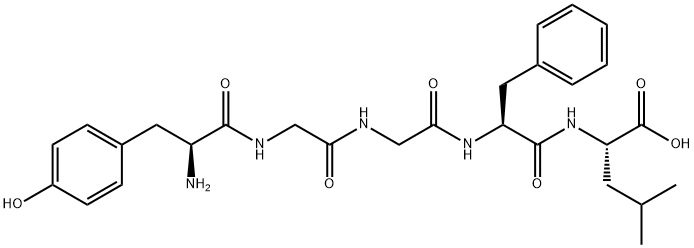CHEMICAL AND PHYSICAL PROPERTIES
| Physical Description | Solid |
|---|---|
| Collision Cross Section | 228.1 Ų [M+H]+ 222.6 Ų [M-H]- |
COMPUTED DESCRIPTORS
| Molecular Weight | 555.6 g/mol |
|---|---|
| XLogP3 | -2.3 |
| Hydrogen Bond Donor Count | 7 |
| Hydrogen Bond Acceptor Count | 8 |
| Rotatable Bond Count | 15 |
| Exact Mass | 555.26929854 g/mol |
| Monoisotopic Mass | 555.26929854 g/mol |
| Topological Polar Surface Area | 200 Ų |
| Heavy Atom Count | 40 |
| Formal Charge | 0 |
| Complexity | 854 |
| Isotope Atom Count | 0 |
| Defined Atom Stereocenter Count | 3 |
| Undefined Atom Stereocenter Count | 0 |
| Defined Bond Stereocenter Count | 0 |
| Undefined Bond Stereocenter Count | 0 |
| Covalently-Bonded Unit Count | 1 |
| Compound Is Canonicalized | Yes |
PRODUCT INTRODUCTION
description
Leu-enkephalin is a pentapeptide comprising L-tyrosine, glycine, glycine, L-phenylalanine and L-leucine residues joined in sequence by peptide linkages. It is an endogenous opioid peptide produced in vertebrate species, including rodents, primates and humans that results from decomposition of proenkephalin or dynorphin and exhibits antinociceptive properties. It has a role as a delta-opioid receptor agonist, a mu-opioid receptor agonist, a neurotransmitter, an analgesic, a human metabolite and a rat metabolite. It is functionally related to a L-tyrosine, a glycine, a L-phenylalanine and a L-leucine. It is a tautomer of a Leu-enkephalin zwitterion.
